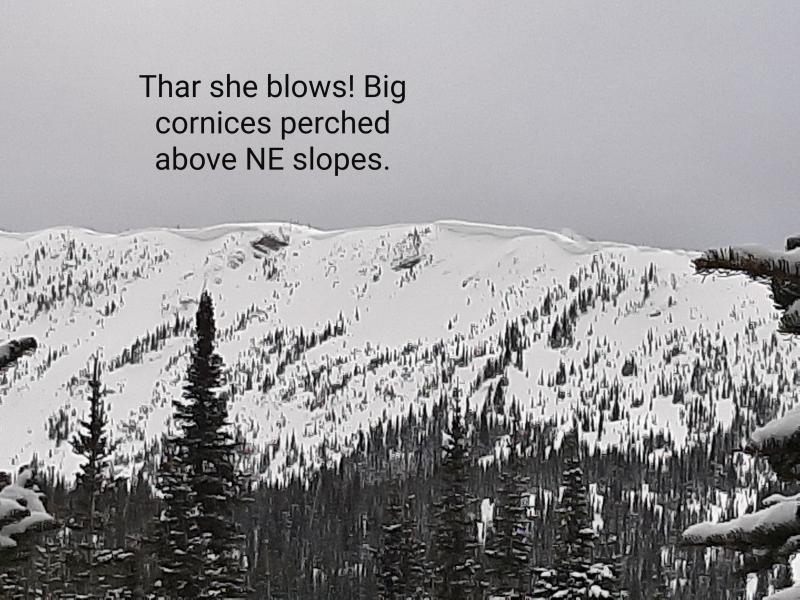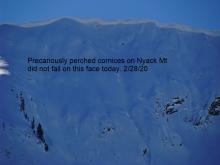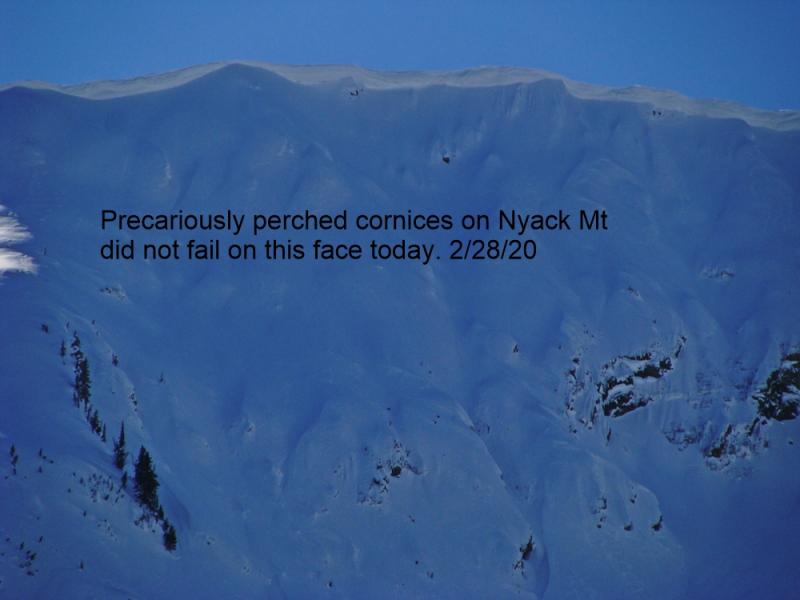| Sunday | Sunday Night | Monday | |
|---|---|---|---|
| Cloud Cover: | Warming and sunny. | Clouds move in and showers begin. | Continued showers. |
| Temperatures: | 43-55 deg. F. | 28-35 deg. F. | 37-50 deg. F. |
| Wind Direction: | S | S | SW |
| Wind Speed: | 4 | 6 | 13-15 gusts 24-29 |
| Snowfall: | 0 in. | 0 in. | 0-1 in. |
| Snow Line: |
Whitefish Range
Swan Range
Flathead Range and Glacier National Park
How to read the forecast
Warming and sunshine led to both natural and human triggered avalanches over the past 48 hours. The avalanche danger is CONSIDERABLE above 5500 feet. Human triggered avalanches will become likely as the sun weakens the snow surface and large cornices. Natural avalanches will also be possible so limit exposure to run-out zones, particularly in the heat of the day. Weak snow near a series of crusts exists in the upper snowpack that should be assessed before committing to a slope.

3. Considerable
?
Above 6500 ft.
3. Considerable
?
5000-6500 ft.
2. Moderate
?
3500-5000 ft.
- 1. Low
- 2. Moderate
- 3. Considerable
- 4. High
- 5. Extreme
-
Type ?
-
Aspect/Elevation ?
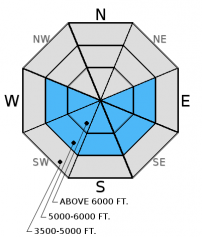
-
Likelihood ?CertainVery LikelyLikelyPossible
 Unlikely
Unlikely -
Size ?HistoricVery LargeLargeSmall

Yesterday we received multiple reports of both slab and loose natural avalanche activity due to the abundant sunshine and warm temperatures. Today, temperatures are expected to be a few degrees warmer and have already climbed above freezing in some areas. It is time to move to a more shaded slope when the surface becomes moist and roller balls/pinwheels form on steep slopes. Also, stay out from under sunny slopes as the day progresses. Though loose snow avalanches are a manageable problem, they are dangerous as they can entrain a lot of snow and move very fast. The consequence of small, loose avalanches can be amplified if you are caught in or around a terrain trap like a narrow gully, cliff band, or in the trees.
-
Type ?
-
Aspect/Elevation ?
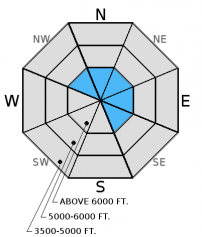
-
Likelihood ?CertainVery LikelyLikelyPossible
 Unlikely
Unlikely -
Size ?HistoricVery LargeLargeSmall

Sunny aspects should show plenty of obvious signs of instability today, but not as obvious in the shade. The potential for cornice fall can create a sun-induced problem on the shaded side of the compass. We have recently observed some monster cornices across the area. The sun and warming temperatures expected again today will weaken these and may cause them to fail. The huge amount of stress a falling cornice puts on the snowpack can trigger deeper weak layers like lingering windslabs or weak snow around the late February crust. Skiers near Mt. Grant observed cornice fall and subsequent slab avalanches yesterday. Cornices can release farther behind the ridgeline than expected so it is important to keep a safe distance when traveling above them and limit your exposure time when traveling below.
With warming and intense sunshine today creating more cohesive slabs, it is still possible that you could also trigger a lingering wind slab even without the help of a cornice.
-
Type ?
-
Aspect/Elevation ?

-
Likelihood ?CertainVery LikelyLikelyPossible
 Unlikely
Unlikely -
Size ?HistoricVery LargeLargeSmall

It remains important to evaluate the upper snowpack for weak snow around the series of crusts that are 1.5-3 feet from the surface, and assess the reactivity with stability tests. While we have not had recent reports of avalanches releasing on these weak layers, stability tests in most locations show they still have the potential to break across a slope (video1, video2). Where you find weak, faceted snow around these crusts it is important to choose appropriate terrain as it is possible to trigger an avalalanche. Put the odds in your favor by avoiding steep, convex roll-overs, and rocky terrain where the snowpack is notoriously shallow.
*Note correction in details of avalanche reported on Friday (3/18) on Peak 6996, see avalanche observation.
Saturday: Skiers in the Mount Grant vicinity in the Flathead Range reported wind slab, glide, and wet loose, natural avalanches that occured yesterday (observation). They noted that no crusts existed in the upper snowpack above 7000 feet, and observed large surface hoar crystals on the surface. Interestingly, a glide crack failed on smooth rock slabs that triggered a shallower slab (image). Another party of skiers in the Skiumah Drainage observed natural avalanche activity on north and northwest aspects on Mt. Penrose. Mark and I were in Canyon Creek in the southern Whitefish Range. On shaded aspects we found 14 inches of low density snow on top of a supportable crust. We found buried surface hoar 2-3 feet from the surface that in some areas was well preserved, and in othe areas was decomposing (observation). Skiers on Elk Mountain in southern Glacier Park observed strong wind transporting snow along high ridgelines. They also noted a wet snow surface, deep boot penetration, and roller balls forming on sunny aspects.
Friday: Skiers on Peak 6996 near Marias Pass in the Flathead Range unintentionally broke two large blocks of cornice. The cornice triggered an avalanche that propagated 40-60 feet across the slope and ran about 400 feet. One skier was caught and reported that they "got a little beat up" (observation). Skiers on Essex Mountain in the Flathead Range found the late February crust 2 feet from the surface with small, facetes above. They also noted another round of surface hoar forming on the surface (observation). Snowmobilers in Kimmerly Basin in the Whitefish Range noted glide cracks opening on sunny slopes. Snow bikers in the Lost Johnny/Strawberry Lake area in the Swan Range found excellent riding conditions. The snow surface softened as the day progressed and they observed small, loose, wet avalanches in the upper elevation terrain (observation).
Thursday: Erich and I rode around the Doris Creek/Blaine Mountain area in the Swan Range yesterday. We found excellent riding with 16-20 inches of snow above the rain crust from last weekend. Wind slabs near the ridges produced isolated cracking, but we avoided steep wind loaded terrain. We also found weak snow above two crusts about 2 -3 feet from the surface that fractured and propagated in our stability tests (observation and video).
Visit our Observations page and our You Tube channel for more observations from the entire season.
Thanks to everyone for submitting observations. They are extremely useful and could help save lives.
HOW TO SUBMIT OBSERVATIONS:
Email: [email protected]
Call and leave a message: 406.387.3821
You can also submit quick observations via text: 406.241.4571 (FAC mobile)
OR
Submit Snowpack Observations: http://www.flatheadavalanche.org/node/add/snowobs
Submit Avalanche Observations: http://www.flatheadavalanche.org/node/add/avyobs
Today is the last warm and sunny day before an approaching system moves into the area tonight and we return to a more showery pattern. Yesterday saw temperatures in the low 40s, and they are expected to climb even higher today. Currently, mountain temperatures are already on their way up ranging from 20º-34º F. Winds are out of the southeast and southwest at 1-9 mph with gusts from 6-12 mph. This evening clouds should begin to move in behind the exiting high pressure ridge and showers begin later in the night.
| 0600 temperature: | 20-34 deg. F. |
| Max. temperature in the last 24 hours: | 35-42 deg. F. |
| Average wind direction during the last 24 hours: | S |
| Average wind speed during the last 24 hours: | 5-9 mph |
| Maximum wind gust in the last 24 hours: | 11-19 mph |
| New snowfall in the last 24 hours: | 0 inches |
| Total snow depth: | 81-108 inches |
This advisory applies only to backcountry areas outside established ski area boundaries. This advisory describes general avalanche conditions and local variations always occur. This advisory expires at midnight on the posted day unless otherwise noted. The information in this advisory is provided by the USDA Forest Service who is solely responsible for its content.













